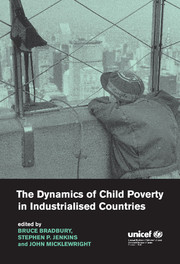Book contents
- Frontmatter
- Contents
- List of figures
- List of tables
- Notes on the contributors
- Acknowledgements
- 1 Beyond the snapshot: a dynamic view of child poverty
- Part I Issues and cross-national evidence
- Part II Topics in child poverty dynamics
- 5 Income mobility and exits from poverty of American children
- 6 Child poverty in Germany: trends and persistence
- 7 Poverty among British children: chronic or transitory?
- 8 Child income poverty and deprivation dynamics in Ireland
- 9 Young people leaving home: the impact on poverty in Spain
- 10 Are children being left behind in the transition in Hungary?
- 11 Mobility and poverty dynamics among Russian children
- Summary and policy conclusions
- Index of authors
- Index by subject
11 - Mobility and poverty dynamics among Russian children
Published online by Cambridge University Press: 02 December 2009
- Frontmatter
- Contents
- List of figures
- List of tables
- Notes on the contributors
- Acknowledgements
- 1 Beyond the snapshot: a dynamic view of child poverty
- Part I Issues and cross-national evidence
- Part II Topics in child poverty dynamics
- 5 Income mobility and exits from poverty of American children
- 6 Child poverty in Germany: trends and persistence
- 7 Poverty among British children: chronic or transitory?
- 8 Child income poverty and deprivation dynamics in Ireland
- 9 Young people leaving home: the impact on poverty in Spain
- 10 Are children being left behind in the transition in Hungary?
- 11 Mobility and poverty dynamics among Russian children
- Summary and policy conclusions
- Index of authors
- Index by subject
Summary
Introduction
In creating a free economy, we consciously departed from the rigid regimentation and regulation of all aspects of life, and failed to notice how the state was increasingly becoming indifferent to the fate of its children … It cannot continue like this, we urgently need to change the situation. This has to start from the state. (Boris Yeltsin 1997)
It is now abundantly clear that the tremendous economic and social changes associated with the Russian transition have led to a serious deterioration in living standards. Dramatic increases in poverty have been well documented (Doyle 1996, Klugman and Braithwaite 1998, Kolev 1996, Milanovic 1998, World Bank 1995). This trend at the aggregate level has occurred alongside substantial and increasing differences in poverty across family types. Families with children have been particularly affected, especially singleparent families and those in rural areas (Klugman and Kolev 1999).
Rising poverty generally, and especially among children, is obviously worrying. For policymakers, an understanding of the flows of children into and out of poverty is important for the choice and design of government (or non-government) interventions that might seek to influence those flows. Against this background, this chapter is the first study of mobility and poverty dynamics among children in Russia.
In the next section we put the situation of children in Russia in the mid-1990s into the context of the economic and social changes associated with the transition. We then discuss our data and definitions before turning to look at three issues.
- Type
- Chapter
- Information
- The Dynamics of Child Poverty in Industrialised Countries , pp. 254 - 280Publisher: Cambridge University PressPrint publication year: 2001
- 1
- Cited by

